
What are goals?
Google Analytics ‘goals’ allow you to measure specific actions that users carry out on your site. They can track events like a submitted enquiry form, a brochure download or a completed transaction. That’s why it’s important to set up sensible and comprehensive goals from the outset – only then will conversion rates be calculated and shown in Analytics reports.
Goals can be triggered by one, or a combination of activities that include page views, button presses and form submissions.
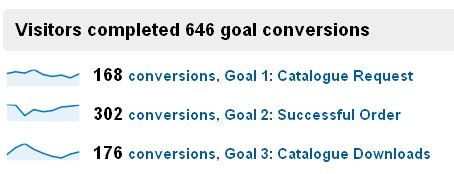
You can use up to 20 goals, grouped into four sets of five, within each Analytics profile – if you need to track more then you’ll need to add an additional profile to your account. But don’t worry: 20 is more than enough for most purposes.
Setting up page view goals
Goals are most commonly triggered by a page view. For example, a ‘thank you page’ view will indicate that a user has completed your contact form and been directed to the next stage.
So, how do you measure something like this in Analytics?
First of all, navigate to your list of website profiles and select ‘Edit’ next to the name of the website you are working on.

You’ll be taken to a screen on which all your available goals are listed.

Click on ‘Add goal’ and then give your goal a clear name – the easier it is to recognise in your reports, the better.
Next, select ‘URL Destination’ as the goal type. We will go on to look at the other options at the end of this post.
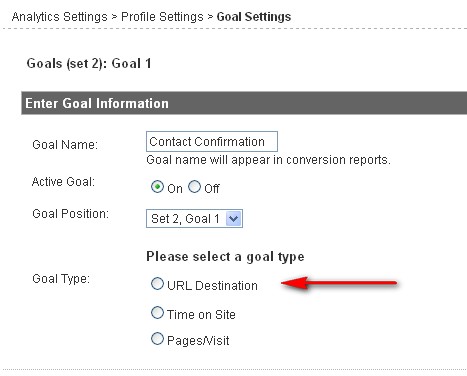
Match Types
At this point you will be asked to enter a ‘match type’. You have three to choose from.
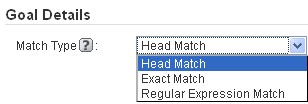
Head Match will match your goal URL to the leftmost part of the page URL – this means that dynamic addresses can be tracked. For example, where a unique identifier is used in the URL /thankyou.html?id=1234567 a goal would be triggered if the Match Type is set to ‘Head Match’ and the goal URL is set as /thankyou.html
Exact Match matches the goal URL only to the exact page URL that appears in your reports.
Regular Expression Match allows URLs that use the same regular expression to trigger the same goal. For example, you could ensure that dynamic URLs such as www.mysite.co.uk/?editpage=11567830 and www.mysite.co.uk/instock/?editpage=90385382 both triggered the same goal – both use the regular expression ‘editpage’.
Top Tip: if you need to test which goal URL to use, either because you have dynamic URLs or a number of pages that relate to the same goal, you can construct a RegEx expression in the Top Content report filter box (at the bottom of the Top Content Report page). This will show the page views that will trigger a goal using that expression. Simply copy and paste the expression into the Goal URL section and select “Regular Expression Match” as the match type.
Goal Values
It is possible to assign a monetary value to a goal. If a completed goal has a commercial outcome, it can be assigned to the goal value. If you know you have an average online order value of £500, and you know that about 10% of enquiries result in a sale, you might assign £50 to your goal value.
It is worth noting that, whilst goal values give you an indication of how much your traffic is worth, the function is not as versatile as e-commerce tracking, which is covered later in this blog series. E-commerce tracking can attribute values and specific products to transactions, but there’s nothing to stop you using Goal Values as well.
Using additional steps and funnel visualisations
By including additional steps in the goal process, it is possible to monitor the whole process in a visual format. For example, you can gather statistics for every stage of a purchase – the number of people who add items to a basket, the number who go on to the checkout and the number who complete their purchases. You can add up to ten steps in these ‘funnels’.
In this way, you can see the points at which visitor drop-out is occurring and identify possible weaknesses in the funnel. If you can identify the pages that users are navigating to instead of the ones you want them to go to, it will help you optimise the buying process – and ultimately provide information that can help you to improve conversion rates.
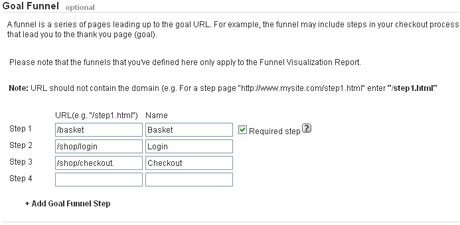
The funnel visualisation:
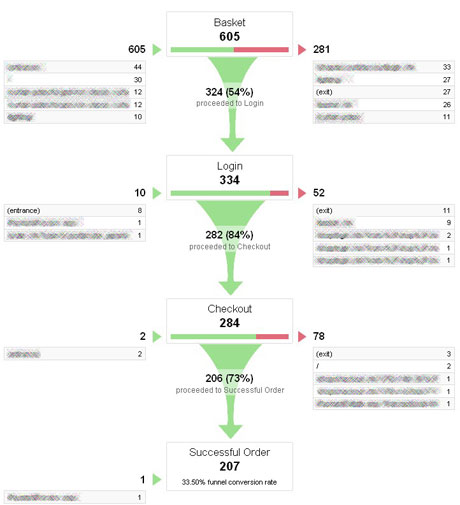
Engagement based goals
In its most recent update, Google added the option to use different goal types instead of the standard ‘URL Destination’ goal.
You can now measure goals that rely on ‘time on site’ and ‘pages/visit’. These allow you to record goals when a certain threshold has been reached (either greater or less than the predetermined value) for a set time on site, or a number of pages per user visit.
Finally, once your goals are set up and they have collected data, you’ll see new statistics in your visitor, content and goal reports – allowing you to analyse goals within different segments of your Analytics data.
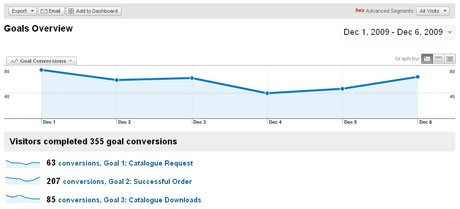
Thanks to goals, you are not only able to measure how effective your website is, but you can use the data you collect to refine the way it works. It’s just one part of what we call ‘marketing you can measure’.

.jpg)